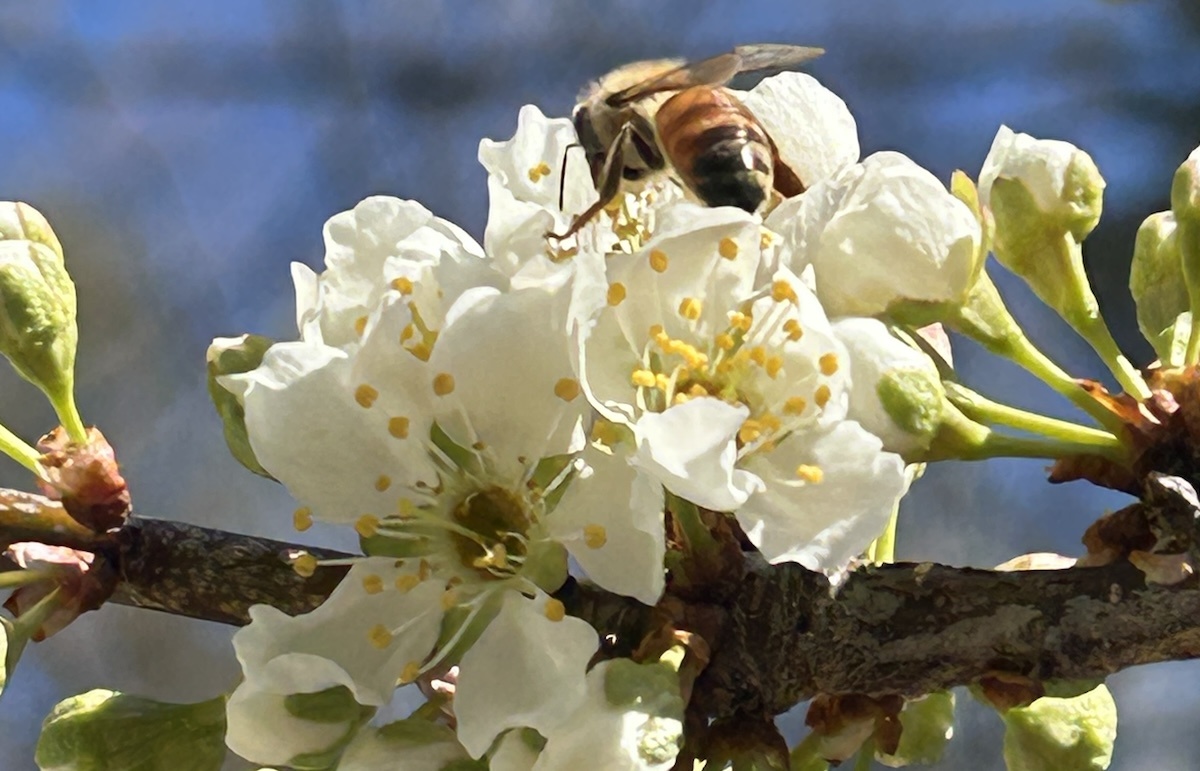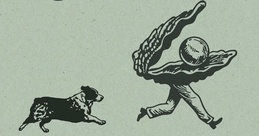
Buzz Kill?
What’s threatening northern Michigan’s main pollinators (and how we can help)
By Kierstin Gunsberg | Aug. 2, 2025
It’s been a summer of bummer news for our pollinator friends, from scientists reporting the presence of microplastics in bee brains to stats showing that this year’s commercial honeybee population saw mass die-offs nationally.
And bad news for the bees is bad news for us. New research published by the Proceedings of the National Academy of Sciences (PNAS) finds that pollinating insects, including beetles, moths, and even wasps, contribute $18 billion to U.S. agriculture revenue annually. Up North, that includes our cherry crops, which make up over 40 percent of the nation’s tart cherry haul.
So what does that mean for northern Michigan’s VIPs (Very Important Pollinators)? Here’s a look at what they’re up against, how they’re faring in a season of wildfire haze, and the simple ways we can help them thrive.
Very Busy Bees
JC Bailey is standing amid the orchestrated frenzy of the 1 million honeybees she’s raising on her farm in Traverse City. As summer hits its dog days, the bees celebrate something called the “honey flow” when they finally get to feast on all of their favorite buds like star thistle and milkweed.
The honey flow can last anywhere from a few weeks to the whole summer, depending on how the weather is treating the plants and trees the bees depend on. Either way, it’s always action packed. “They’re just dropping and going, dropping and going. It’s just nonstop,” says JC, who runs Bailey’s Farms, a kombucha brand, with her husband Steve.
Despite Steve’s bee allergy, the couple manages a total of 29 hives. “It’s an amazing sight to stand here,” says JC. “They don’t care about me. They just have a job to do.”
That job is storing honey to nourish the colony through the winter. For the Baileys’ hives, that amounts to 50 to 100 pounds of honey per hive, with JC and Steve taking a little back to sell under their Bailey’s Farms brand. Sometimes jars of their small batch honey hit their product line as well.
But the couple, who launched their apiary six years ago with just two hives, haven’t made a business out of their beekeeping.
“We do small batches [of honey] because that’s our preference,” JC says. Producing more honey would mean amping up their production with commercial practices like swapping out ageing queen bees for younger ones or importing swarms from other parts of the country (migratory beekeeping) to speed up and multiply pollination, things that are commonly used by large-scale honey and fruit producers in northern Michigan, but that can also contribute to some of the honeybee’s greatest threats.
The Mite Fight
As honeybees face what may be their worst year on record—commercial colony deaths are expected to spike 10 to 30 percent over the average losses of the past decade—practices like migratory beekeeping are coming under scrutiny.
While moving hives around can boost both crop and honey yields, it also helps spread the varroa mite, parasites that are deadly to bees and getting harder to kill thanks to pesticide resistance.
“You can have your whole hive collapse and die from these mites,” says JC, who’s currently treating her colonies with oxalic acid, an organic compound.
It’s not just honeybees at risk of varroa mites and human-led threats like pesticide spraying and habitat or fauna reduction. Michigan State University estimates that across Michigan, over 460 species of wild, native bees do their part to pollinate the state. NoMi’s long list of non-cherry crops—apples, blueberries, elderberry, mint, and even willow trees—benefit from them.
And, argue some critics, raising honeybees is harming wild, native bee populations by creating too much competition for food.
Beyond the Bees
Bees might be the headliners, but they’re not the only ones making sure our farmer’s markets are slammin’ this season. Monarch butterflies love a good patch of wildflowers, and hawk moths can’t resist a lilac tree.Birds make an impact too. While several species do their part, northern Michigan’s most common and reliable bird-pollinator is the ruby-throated hummingbird, a tiny powerhouse that loves flowers and migrates all the way from Mexico to the Great Lakes each spring, usually landing in late April.
But thanks to climate change pressures, that schedule’s getting out of whack, says Benzie Audubon Club president Doug Cook. “Plants are flowering earlier than in the past,” he explains. And if the ruby-throated hummingbird doesn’t start adjusting its arrival to match up with when the plants it eats are actually flowering, “there will be negative effects” Cook fears.
What about Wildfire Smoke?
The shifting climate is hurting bees too. Northern Michigan’s record-breaking 2023-2024 winter was unseasonably warm and when that happens, says JC, “the bees go through more honey,” leaving them with less fuel come spring, right when they need it most.
And then there’s a newer problem to face in our area: wildfires. Summer haze drifting down from Canada is becoming a regular summertime occurrence. While the fires themselves can destroy bee habitat, it’s still unclear how much the smoke actually affects bees. So far, says JC, northern Michigan’s bees “really don’t seem to be affected as far as we can tell from a foraging standpoint.”
As for their little lungs, that part’s still fuzzy. But behaviorally they seem to be unchanged. “The whole sky is just full of bees that are zipping around and on their missions,” she says.
The Birds & The Bees 101: How to be better neighbors to pollinators
It may not be all rainbows and butterflies for the birds and the bees right now, but both JC and Cook report that though the big-picture numbers look dire, locally, bird and bee populations seem to be holding steady. And with a little help from their friends (that’s us!) it can stay that way. Here’s how.
Keep feeders clean. Who doesn’t love a fleeting moment of bird-watching bliss? Unfortunately, feeders can become hotspots for the spread of avian flu. Cook recommends restocking them every few days with fresh food and syrup and giving them a good scrub down then too.
Go for nectar-rich, native plants. Pollinator plant seed packets are a good start, but it’s even better to choose varieties native to northern Michigan. Both Cook and JC say that native species like echinacea and wild columbine support local pollinators best. “We make sure the plantings we select are good sources of nectar or that they contribute to [the] habitat required of local bird species,” says Cook.
And, adds JC, leave native wildflowers and milkweed, often mistaken for weeds, alone. “Right now, the bees are feasting on the milkweed,” JC says. “Growing up, it would be like, ‘Oh, get rid of the milkweed!’ Now, no matter where it pops up—even in the most inconvenient spot—it stays there.”
She adds not to forget the overlooked wild bees when planning a pollinator garden. “Honey bees really don’t go to chamomile, but the wild bees love chamomile,” she says. “So, I’ll plant chamomile just for the wild bees.”
Plan for late bloomers. Pollinators need food beyond summertime. Afterall, they’re still buzzing about through early autumn. JC recommends planting anise hyssop and sedum, a type of succulent that flowers late in the season. “In the summertime you have all these things to forage on, and then all of a sudden it comes to September, October, and there’s nothing for the bees. So they start eating into their honey stores.”
Trending

Our Top Stories of 2025
Each year, we look back at the stories we’ve shared over the last 12 months and pull together the ones that got the mo… Read More >>
Winter Break at the Library
Trying to keep the kids busy while school is out? Head to the library! Dec. 22, take your 12+ tweens and teens to the Mesick… Read More >>
Umbo Is Coming...to The Little Fleet
Winter isn’t just coming—it’s already here. But if you want a break from the December blues, head to The L… Read More >>


